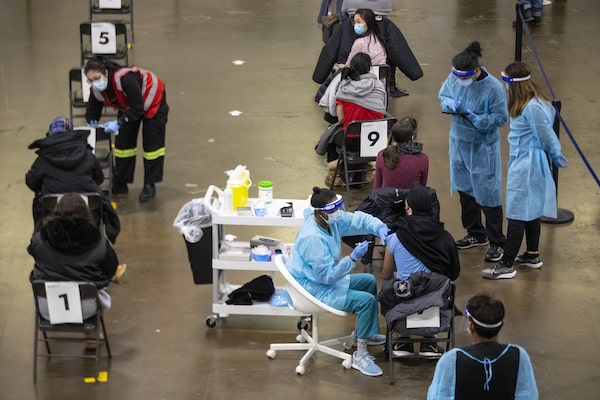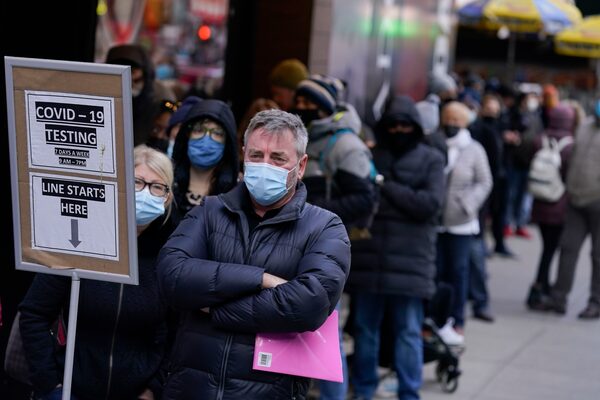
A COVID-19 vaccine is administered at a mass vaccination clinic run by Switch Health in Mississauga, Ont., on Dec. 24.Chris Young/The Canadian Press
Health officials in the United States this week cut COVID-19 isolation restrictions for asymptomatic Americans from 10 to five days, leading some Canadians to wonder whether similar recommendations could be adopted here.
The Centers for Disease Control and Prevention said its new guidance is in keeping with evidence that people with COVID-19 are most infectious in the two days before and three days after symptoms develop.
While some experts say the move is necessary to curb strain on hospitals as more and more staff become infected or exposed to the highly transmissible Omicron variant, others argue the approach is flawed, and “fraught with danger.”
World junior hockey championship cancelled due to COVID-19 cases on multiple teams
“If somebody tested positive and a few days later … you had to sit next to them on the subway, how would you feel?” said Raywat Deonandan, an epidemiologist with the University of Ottawa.
“A certain number of days is not sufficient (when) we’re looking for indication of non-infectious status.”
Dr. Zain Chagla, an infectious disease expert with McMaster University, said the CDC guidance is meant to avoid “secondary consequences” of having large numbers of essential workers isolating for 10 days.
Halving recommendations for isolation and quarantine isn’t the perfect solution, Chagla said, noting the infectious period with COVID-19 “is not set in stone.” But the move is realistic, he added.
“The reality of the situation is we have to be a little bit pragmatic about what’s coming and the number of people that will be infected or exposed to COVID-19,” he said.

A person stands near the window of a room at a government-authorized COVID-19 quarantine hotel in Richmond, B.C., on Feb. 28.DARRYL DYCK/The Canadian Press
How likely is Canada to adopt similar guidelines?
The Public Health Agency of Canada said in an e-mail Wednesday it was aware of the new CDC guidance, adding it would “inform Canadians should there be an update to (Canada’s) recommendations in the future.”
Quebec said Tuesday certain health workers who have tested positive for COVID-19 will be allowed to stay on the job – on a case-by-case basis – a move the province said is necessary to keep the health-care system operational.
Alberta Premier Jason Kenney said Tuesday there was no immediate plan to follow Quebec’s decision.
Manitoba said Monday it may consider similar recommendations if there is further strain on its health system while Ontario said it’s also contemplating shortening isolation and quarantine.
Cynthia Carr, an epidemiologist in Winnipeg, said whatever guidance provinces adopt should focus on symptoms rather than the calendar to determine when to drop isolation measures.
“You don’t just lock in on the five days, you lock in on how you’re feeling,” she said. “If you have any symptoms at all that is absolutely the most important factor, even if guidelines were to change in Canada.”
A child receives the COVID-19 vaccine at Scarborough Health Network's Centenary Hospital in Scarborough, Ont., on Dec. 10.NICK LACHANCE/Reuters
What’s the science behind the CDC guidelines?
The CDC website says the change is “motivated by science” of when transmission is most likely to occur.
The reduced isolation is meant only for those who are asymptomatic after five days, the agency says, adding it should also be followed by five days of wearing a mask in public.
Deonandan said the guidance is based on pre-Omicron data, however, and the contagious period of the new variant could differ from previous strains. The window of contagiousness will also vary from person to person, he added.
“That’s worrying,” Deonandan said. “It’s entirely possible that many cases will not be experiencing the average number of days of infectiousness.”
Carr said it’s still unknown whether the period of infectiousness changes with Omicron, but a person’s own degree of contagiousness depends on factors including their immune system.
She added the incubation period with Omicron – the time between infection and symptom-onset – appears to be shorter than previous strains.
“That would stand to reason that your infectious period is very close to the point at which you are infected,” she said.

People wait in line at a COVID-19 testing site in New York's Times Square on Dec. 13.Seth Wenig/The Associated Press
How do you know if you’re no longer contagious?
Deonandan said one of the biggest flaws with the CDC’s guidelines is that it doesn’t require a negative test at the five-day mark, adding the best way to determine whether the virus is still present and potentially transmissible is through repeated testing.
What’s the difference between a rapid COVID-19 test and a PCR test, and which one is best?
But what if you don’t have access to multiple tests?
During times when supply is low, Deonandan said rapid tests may need to be reserved for health-care workers to ensure they can safely return to work after an infection.
Carr said the CDC’s argument for shortened isolation stems from their data, which suggests 85 to 90 per cent of transmission happens in that five-day time period. But since asymptomatic people can’t be sure they’ve cleared the virus without a test, they should still rely on risk-mitigation strategies, including wearing a tight-fitting mask in public.
Those who have symptoms at the five-day mark shouldn’t end their isolation, she added.
What do you do if you think you have COVID-19?
Securing a timely appointment for a PCR test is becoming more difficult with many jurisdictions reaching testing capacity, and health experts warn daily case counts are likely much higher than what’s being reported.
Health Canada’s website says people should contact their “local health authority” for advice about testing if they think they have COVID-19 or have been exposed to someone who recently tested positive.
Some provinces are starting to rely more heavily on rapid tests to help alleviate strain on testing centres.
Manitoba this week said it would make take-home, self-administered rapid tests available at provincial testing sites and only ask people to return for a PCR if their take-home test is positive.
U.S. health authorities on Dec. 27 shortened the recommended time for isolation for asymptomatic Americans with COVID-19 to five days from the previous guidance of 10. Tamara Lindstrom reports.
Reuters
Is Omicron producing a more mild illness?
Early research suggests Omicron may cause milder illnesses than earlier versions of the virus. But the sheer number of people becoming infected threatens to crush hospital capacity, experts say.
Carr said early data on Omicron stemmed from cases in mostly younger populations who weren’t at risk for hospitalization, and more data is needed before scientists can definitively say the variant is less severe.
She noted that even a 40 to 60 per cent reduction in hospitalization with Omicron could be negated by the sheer transmissibility of the variant.
“The reduction in risk might not be enough to account for the escalation in cases,” Carr said.
Sign up for the Coronavirus Update newsletter to read the day’s essential coronavirus news, features and explainers written by Globe reporters and editors.